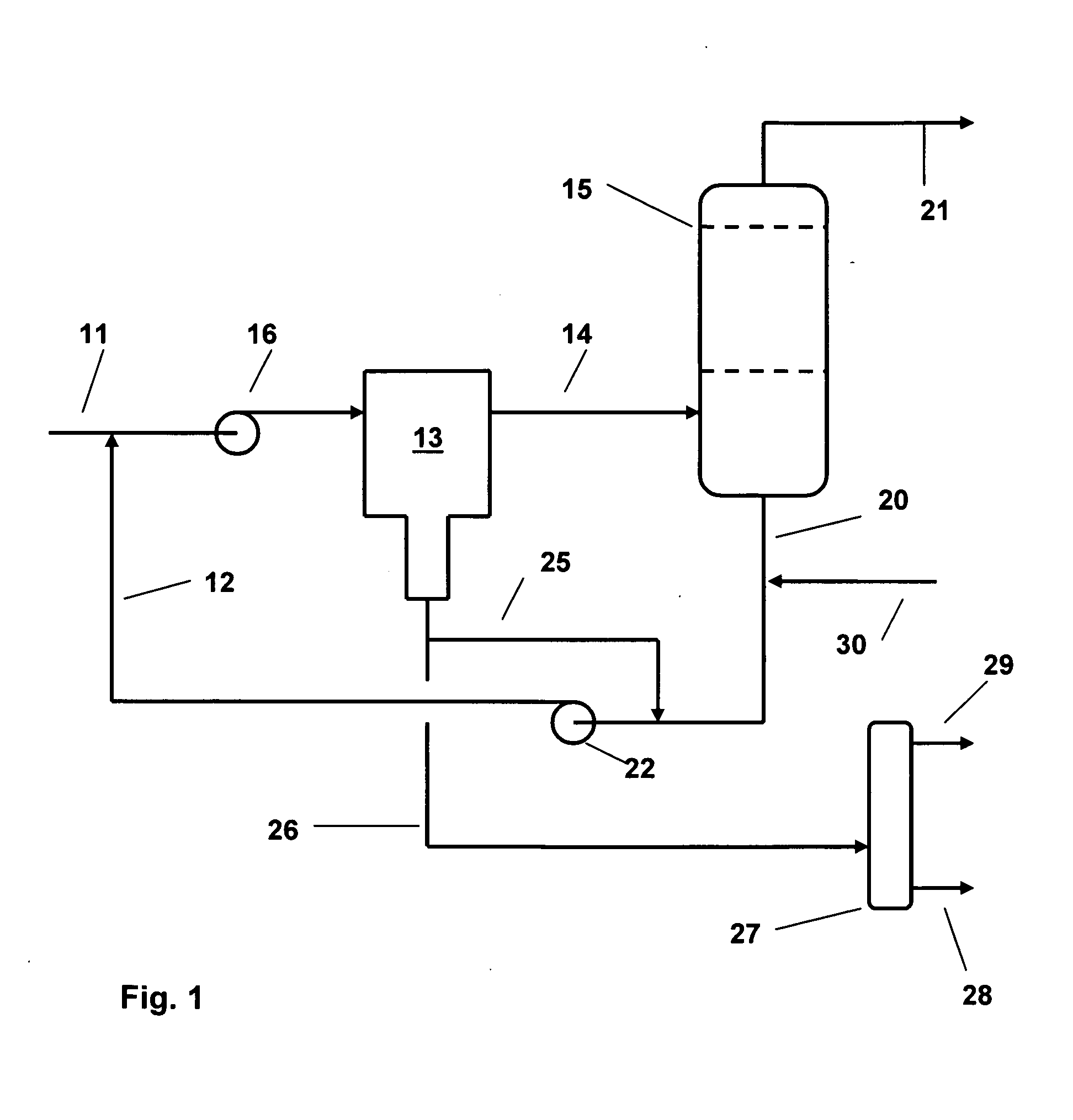[0010]We have now devised a method of operating a salt dryer which is capable of increasing the efficiency of the dryer in terms of amount of water removed per unit weight of drying salt. According to the present invention, water is removed from liquid and gaseous hydrocarbons by contacting a feed stream of the
hydrocarbon with an
aqueous solution of a salt drying agent prior to passing the stream through a salt dryer to remove part of the water in the stream. The aqueous solution of the salt drying agent is generated in the salt dryer when the partly dried stream comes into contact with the drying salt and forms the solution in one or more stages. The solution is circulated in a loop from the salt dryer to the incoming feed and then through a liquid / liquid
coalescer which removes a portion of the water together with dissolved salt from the mixture before the mixture is passed on to the salt dryer where further removal of water occurs.
[0011]In this way, the salt dryer is off-loaded by a substantial factor and does not require to remove such a large amount of water; the salt requirements are therefore reduced in proportion to the amount of water removed in the treatment steps which precede the dryer. So, for example, taking
calcium chloride as an example, it may be possible to decrease the consumption of salt to just one fourth of the amount if no pre-drying is used, i.e. to four weight units of water removed for the use of one unit of the salt. The use of a
coalescer to remove
free water / brine—especially slugs of
free water / brine helps to protect the salt
bed from bridging and channel formation and reduces salt consumption in the dryer.
[0012]The present process enables both free and dissolved water to be removed from the stream: although the coalescer removes only the
free water, this initial drying enables the aqueous solution which remains to remove additional dissolved water from the stream before contact with the dry salt takes place. In this way, the effectiveness of both drying steps is made more optimal with overall increases in
process efficiency and reductions in operating costs. Because the coalescers are relatively compact units, they can normally be readily incorporated into existing unit layouts.
[0013]Consistent with the removal of the water during the coalescence / separation, the
water concentration of the circulating treating agent / water blend will tend to increase gradually with transfer of the water in the feed to the circulating fluid. This progressive increase in
water content can be compensated by controlled addition of salt agent to the recirculating fluid coupled with accumulation of the treating agent / water mixture and continuous or periodic dumping of excess mixture. Alternatively, the circulating mixture may be subjected to continuous or batch regeneration or disposed of in any other way which is convenient and economical. Regeneration of the brine further increases the weight of water removed per unit weight of salt, since regenerated
salt solution is recycled, and in the extreme, no salt is consumed. This also eliminates the need to
handle solid salt for some applications, since liquid salt solutions can be used for make-up of the circulating salt inventory. This further reduces the cost of operating a salt dryer, since liquid salt solutions are generally less expensive than the higher grade of crystalline salt “walnuts” or “briquettes” that are preferred for salt dryers. If necessary, the
water content in the circulating loop may be increased to be further away from saturation and
precipitation limits, in order to prevent plugs forming from excessively high salt levels, but still provide sufficient
dehydration to meet specifications or end use performance requirements. The concentration of the circulating salt brine can be controlled at any point between saturation (best
dehydration) to dilute solution (essentially removing only free water). For example, winter fuel production is generally required to be very dry to prevent
ice formation (dehydrated to about 50%
relative humidity), whereas summer fuel production in the same location only requires “clear and bright” at summer ambient temperatures (essentially free water removal only). The concentration of the circulating salt brine can therefore be varied seasonally for minimum salt or
energy consumption, or the
solid salt
packed bed dryer could be taken off line during summer operation.
Packed bed solid salt dryers alone cannot be controlled in this manner, resulting in more salt consumption than is required for many less critical applications.
 Login to View More
Login to View More 


